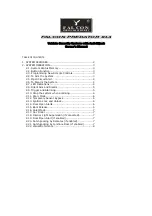
Automatic Fire Detector in Threshold Alarm Technology
Installation
The detector bases are fixed on the ceiling with 2 screws,
after the corresponding preparations have been made.
The detector is mounted horizontally as standard.
The location of the mounting bores can be found in the
“Dimensional drawing” section.
During installation, it is important to ensure that the base does
not warp when installed on an uneven ceiling, as it may make
it difficult or impossible to plug-in the detector. The detector
is placed against the base and screwed onto the base in a
clockwise direction.
Cable connection
With flush-mounted cabling, it is necessary to ensure that all
the required conductors for standard wiring are located on the
“R+” terminal side. The incoming and outgoing conductors
can be inserted through the same aperture on the socket
base (also see the dimensional drawing).
With flush-mounted cabling, it is also advantageous if
both cables are inserted on the side of the base, where
the terminal “R+” and the terminals for all other standard
applications are located.
When introducing the cable from 2 sides, the location of the
base should be selected, so that the breaking points for the
cable entry on the base are offset longitudinally to the cable
path by 180 °. The individual wires can be fed both within the
base interior as well as from underneath the base, from one
half of the base to the other. Cables up to 2 x 2 x 0.8 mm
can be inserted to the base together with the sheath; thicker
cables will require removal of the sheath outside the base.
If the cable shield (sheath wire) of incoming and outgoing
cables is to be looped through, this must be implemented in
the base, e.g. using a ferrule or similar device.
Test activation
A test activation can be undertaken by holding a permanent
magnet at the smoke inlet aperture level (these are also
available on the heat detectors) located at about 100° in a
counter-clockwise orientation starting from the rectangular
opening on the side of the detector base on the detector.
Inspection/Maintenance
Every detector must be physically activated at least once a
year to test its function in accordance with VDE 0833 part 1.
A suitable testing aerosol is recommended for activation of
smoke detectors; heat detectors should be activated using a
heat gun or a hair drier.
Technical Data
Electrical values
Operating voltage
10 to 30 V DC
Quiescent current
consumption
FC650/O
FC650/TMAX-TDIFF
Typ. 90 µA, at typ. 24 V DC line voltage
and 25 °C
Typ. 90 µA, at typ. 24 V DC line voltage
and 25 °C
Alarm current
Max. 40 mA, limited by alarm resistor
in detector base (do not short-circuit)
General data
Temperature range
-30 °C to +70 °C
Application temperature
Max. 45 °C (FC650/TDIFF)
Max. 60 °C (FC650/TMAX)
Activation temperature
57 °C (FC650/TDIFF)
78 °C (FC650/TMAX)
Air humidity
Max. 95 % relative (without condensation)
Enclosure
IP30
Manufacturing date
Label on detector base
Dimensions W x H
Detector
Base
De Base
106 mm x 46 mm
110 mm x 16 mm
110 mm x 54 mm
Weight
Approx. 80 g
Colour
White
Material
Plastic
Approvals
FC650/O
FC650/TMAX
FC650/TDIFF
VdS No. G 210145
VdS No. G 210151
VdS No. G 210151
Applicable standard
FC650/O
FC650/TMAX
FC650/TDIFF
EN 54-7
EN 54-5 – class B
EN 54-5 – class A1R
Specifications according to Building Products Act
0832
10
0832-CPD-1417
FC650/O
0832-CPD-1418
FC650/TMAX
0832-CPD-1418
FC650/TDIFF
EN54-7:2000 + A1:2002
Smoke detectors - Point detectors using
scattered light
EN54-5:2000 + A1:2002
Heat detectors - Point detectors
Side aperture
on detector base
About 100 °
Hold at
aperture height






















